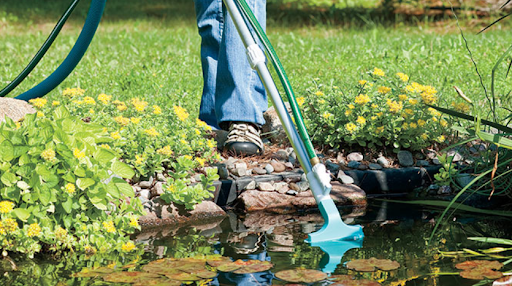A cleaner pond isn’t just about looks—it’s about balance, health, and creating a space where life can truly flourish. Whether your pond is a peaceful backyard retreat or a stunning garden centerpiece, clear, vibrant water transforms it into a living work of art. But without proper care, that serenity can quickly turn into murky water and unwanted algae. The good news? With the right approach and consistent attention, you can enjoy a cleaner pond all year long.
Why a Cleaner Pond Is Worth the Effort
Keeping your pond clean supports far more than appearance—it builds a thriving, natural ecosystem. When water stays clear and healthy, fish have steady oxygen, plants thrive, and foul smells disappear. Maintaining a cleaner pond helps everything stay in harmony.
Here’s what you gain when your pond is in balance:
- Fish enjoy healthier, oxygen-rich water
- Algae growth remains under control
- The pond smells fresh, not stagnant
- Good bacteria multiply and stabilize the system
- Regular maintenance becomes faster and easier
A cleaner pond signals that everything below the surface is working together the way nature intended.
Laying the Groundwork for a Cleaner Pond
Think of your pond as a living organism—it needs structure and care to stay balanced. Building a strong foundation with the right tools and habits ensures clear water and a healthy environment.
Invest in Reliable Filtration
A high-quality filtration system is the heart of a cleaner pond. It keeps water free from toxins, waste, and cloudy buildup. The best systems use two types of filtration:
- Mechanical filtration removes solid materials like leaves and fish waste.
- Biological filtration supports bacteria that break down harmful substances naturally.
Filters from trusted brands such as EazyPod, Evolution Aqua, or drum filters are ideal for koi or heavily stocked ponds.
Use a Skimmer to Capture Surface Debris
A skimmer helps you achieve a cleaner pond by collecting leaves, petals, and other floating materials before they sink and decompose. This small addition keeps your pond surface clean while easing the load on your filtration system.
How Nature Helps Keep a Cleaner Pond
You don’t need to rely only on equipment. Nature can do much of the work for you if you let it.
Add Beneficial Bacteria
Beneficial bacteria are one of the easiest ways to maintain a cleaner pond naturally. These microscopic helpers break down organic matter, reduce sludge, and minimize excess nutrients that encourage algae growth.
Control Algae Without Eliminating It Completely
Every pond has algae—it’s a natural part of the ecosystem. The goal is to control it, not remove it entirely. To maintain a cleaner pond:
- Use a UV clarifier to reduce floating algae.
- Keep a healthy fish-to-water ratio to prevent overfeeding and excess waste.
- Add natural remedies like barley straw or liquid extracts to slow algae growth.
If you notice too much algae, it often means there’s an imbalance caused by too much sunlight, waste, or nutrients. Fixing these issues restores natural clarity.
Consistent Maintenance Creates a Cleaner Pond
The secret to a cleaner pond isn’t hard work—it’s consistency. A few small actions done regularly make a huge difference in water clarity and quality.
Keep Equipment in Good Shape
Check pumps, filters, and UV lights frequently. Clean sponges, clear blockages, and replace parts as needed. Well-maintained equipment ensures proper water flow and prolongs the life of your pond system.
Avoid Overcrowding Fish
Too many fish can quickly overwhelm even the best filtration system. Follow the rule of thumb: one inch of fish per ten gallons of water. This balance keeps your cleaner pond stable and easier to manage.
Let Plants Do the Cleaning
Plants naturally purify water and contribute to a cleaner pond. They filter out excess nutrients, shade the pond, and boost oxygen. A good mix of plant types works best:
- Floating plants like water hyacinth block excessive sunlight.
- Submerged plants like hornwort oxygenate the water.
- Marginal plants absorb nutrients that algae would otherwise use.
Together, these plants form a natural cleaning system that supports water clarity and fish health.
Seasonal Pond Care for Lasting Cleanliness
Your pond changes with the seasons, and your maintenance should adapt too.
Spring and Fall
These are your main cleaning seasons. Use a pond vacuum to remove sludge, clear fallen leaves, and trim back overgrown plants. Refresh filter media and check your entire system before the weather shifts.
Summer and Winter
In summer, provide shade and extra aeration to prevent oxygen loss. In winter, reduce feeding and make sure ice doesn’t completely seal the surface. Gentle seasonal care ensures a cleaner pond year-round.
Simple Habits for Long-Term Pond Clarity
You don’t need to spend hours every week maintaining your pond—just develop simple habits like these:
- Scoop floating debris daily or as needed
- Add beneficial bacteria each month
- Trim dying plants weekly
- Check filters and skimmers twice a month
- Perform deep cleaning two times a year
These small, steady steps are the true secret to a naturally cleaner pond.
Final Thoughts
Achieving a cleaner pond isn’t about constant scrubbing or complicated chemicals—it’s about creating balance between nature and maintenance. When you support your pond with the right filtration, healthy plants, and regular care, the results speak for themselves: clear water, thriving fish, and a calm, natural beauty that lasts all year. Every small effort—removing debris, adding beneficial bacteria, or trimming plants—builds toward lasting harmony. With patience and consistency, you’ll enjoy a cleaner pond that not only looks stunning but also nurtures life in its purest form.
Frequently Asked Questions About Cleaner Pond Maintenance
Can I use chemicals for a quicker clean?
Chemical treatments may clear water temporarily, but they can harm fish and plants. Natural methods are safer and offer lasting results.
Do I need a professional for pond cleaning?
Not always. Most cleaning tasks—vacuuming, adding bacteria, or filter maintenance—are easy to do yourself. For severe algae or equipment issues, professional help may be useful.
Should I ever drain my pond?
Only in extreme cases. With consistent care and seasonal maintenance, full water changes are usually unnecessary.
Can fish live without a filter?
In a lightly stocked, plant-heavy pond, possibly. But most garden or koi ponds need filtration to prevent ammonia buildup and maintain a cleaner pond.
Why is my pond cloudy even after cleaning?
Cloudy water is often caused by excess nutrients or disturbed silt. Adjust feeding, clean your filters, and add beneficial bacteria to restore clarity.
Keep an eye for more latest news & updates on Vents Magazine!

